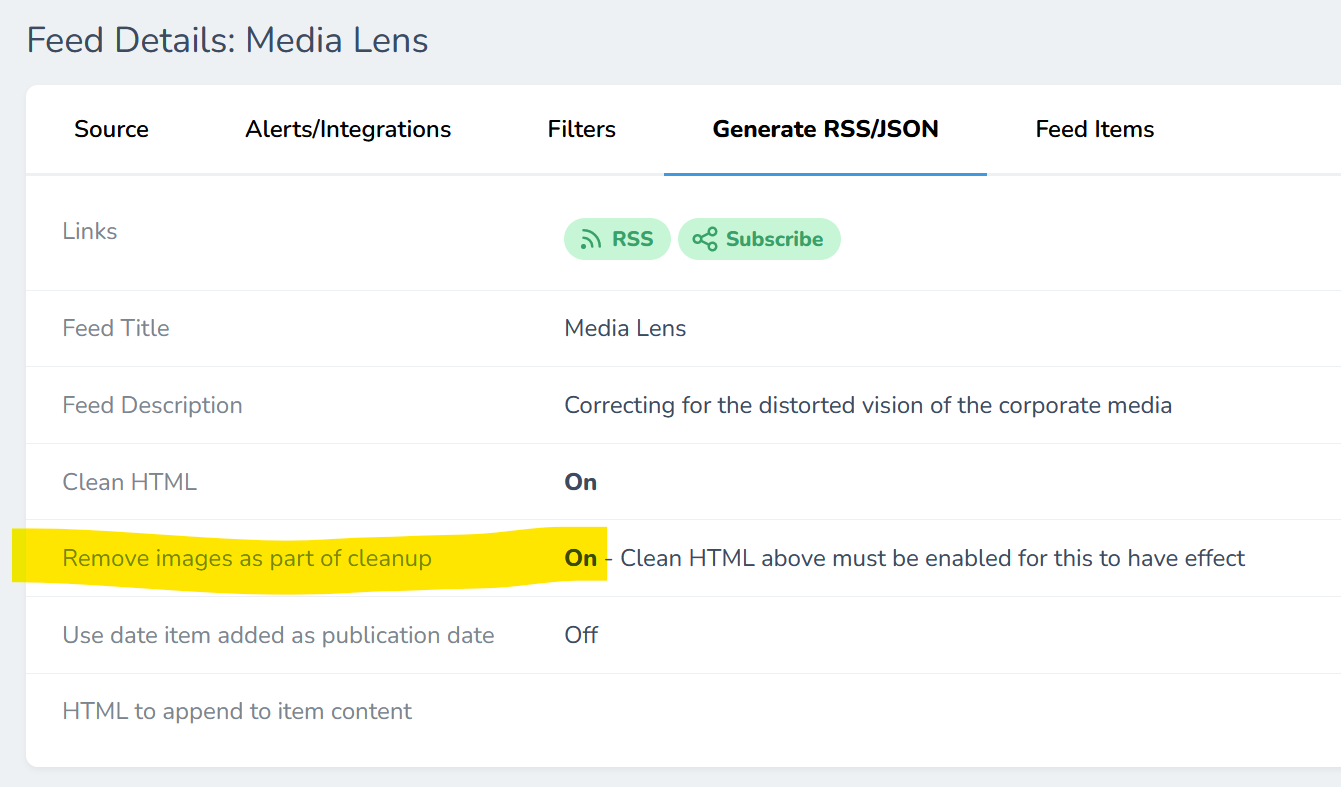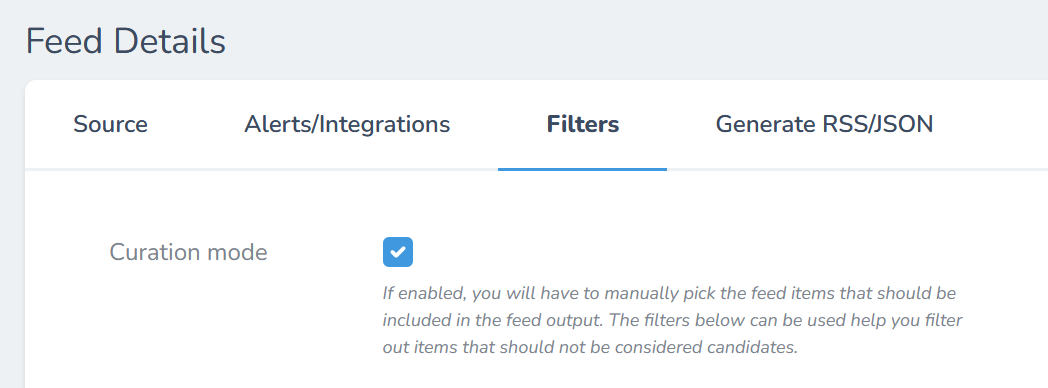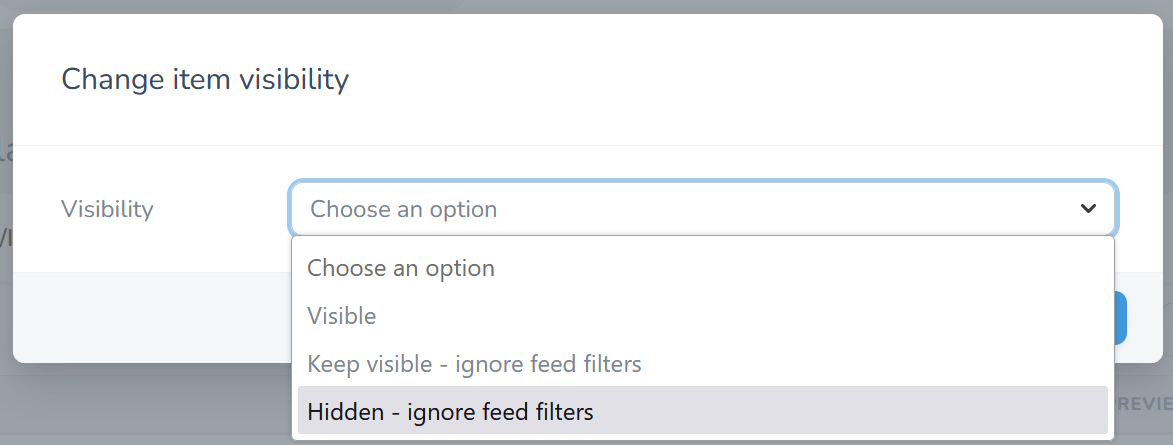Changelog
Follow up on the latest improvements and updates.
RSS
It's now possible to embed your Feed Control feeds on your own website.

Steps
- Click Widgets on the menu
- Select a feed you'd like to embed
- Click 'Save and Customize'
- Set your display options until the preview looks the way you want.
- Copy the HTML code and paste into your own site

This is a new feature, so any feedback appreciated. If things don't look right for your feed, get in touch and we'll be happy to help.
We've just rolled out several exciting updates to Feed Control to improve your experience and give you more control over your feeds.
New Interface

We've redesigned Feed Control with a responsive interface that also allows us to implement new features more easily than before. This might still be rough around the edges, so please let us know if you experience any issues. For now you can still switch to the old UI, but we'll be phasing that out soon.
Feed Export Options

It's now possible to export the feeds you've added to your account in either CSV format or OPML. An OPML export will use the generated feed URLs (if you've enabled feed generation) or the source feed URLs if you haven't.
Note: this will only export the feed data, not the feed items.
Re-Fetch Content for Feed Items
For feeds that have been set up with full-text expansion, it's now possible to manually trigger article extraction on existing feed items.

This can be useful in a number of different cases, for example:
- When you know a feed item's content has been updated and you need the changes reflected in Feed Control.
- After you've set up or modified custom extraction rules to better extract the content you're interested in (see new feature below)
Custom Extraction Rules
Plus and Business plans only. This is an advanced feature. Customers on our business plan can contact us if they need us to set this up for their feeds.
You now have the ability to provide custom rules for feeds with full-text fetching enabled.
This advanced feature gives you greater control over how Feed Control extracts articles from specific websites.
To use this feature:
- Navigate to your feed settings
- Enable "Fetch full-text content"
- Enter custom site configuration in the "Site Config" field
This is particularly useful for:
- Accessing paywalled content - Include authentication cookies to be sent in the HTTP header for sites you're subscribed to
- Fixing article extraction - Specify exactly how content should be extracted from specific sites
body: [XPath]
Use this to specify which element contains the main article content. Multiple statements accepted. Will evaluate in order until a result is found. If not specified or no match found, it will be auto-detected.
body: //div[@id='body']
# also possible to specify multiple
# elements to be concatenated:
body: //div[@class='summary'] | //div[@id='body']
strip: [XPath]
Strip any matching elements and their children. Multiple statements accepted.
strip: //div[@class='hidden']
strip: //div[@id='content']//p[@class='promo']
strip_id_or_class: [string]
Strip any element whose @id or @class contains this substring. Multiple statements accepted.
strip_id_or_class: hidden
strip_id_or_class: navigation
strip_image_src: [string]
Strip any <img> element where @src attribute contains this substring. Multiple statements accepted.
strip_image_src: /advert/
strip_image_src: /tracker/
http_header([header name]): [header value]
Send additional HTTP headers for requests to this site. Only the following headers are accept:
- user-agent
- cookie
- referer
- accept-language
# Appear to be an iPhone
http_header(user-agent): Mozilla/5.0 (iPhone; CPU iPhone OS 18_4_0 like Mac OS X) AppleWebKit/605.1.15 (KHTML, like Gecko) CriOS/135.0.7049.83 Mobile/15E148 Safari/604.1
#
# Skip cookie wall for a particular GDPR system
http_header(cookie): euConsent=true
fixed
Fix for failed items
One of our job queues encountered an issue earlier today, which caused some customers' feeds to fail to update properly with new items.
If you notice a lot of 'failed' status messages next to one of your feed's recent feed items, your feed was likely affected.

We've fixed the issue and new items should be processed okay. If you would like existing items that failed to be tried again, you can select those items showing as failed, and then delete them. After that, please select 'Refresh feed' on the feed actions drop down. This tells Feed Control to check the feed again and process new items.
Please let us know if you experience any trouble.
We’re pleased to announce annual billing for those who want to simplify their billing and enjoy added savings.
You can now pay once for the year and receive a 20% discount. That's more than 2 months free compared to the monthly rate.
Already on a monthly plan?
No problem — when you switch to annual billing, your current monthly payment will be prorated and applied toward the cost of your annual plan. You’ll only pay the difference, and the transition is seamless.
Slack integration fix
We also fixed a bug that was causing the setup of our Slack integration to fail for new connection.
Thanks for using Feed Control and please let us know if you experience any issues. Whether it's related to these new changes or existing functionality.
We've fixed an issue which was causing some feeds to update later than the update frequency set.
If you still experience slow updates with any of your feeds, please let us know.
To see how often Feed Control checks your feed, and the last time it checked it, click on the feed from your list of feeds. On the first tab (Source) you'll find two rows:

Checked every X hours/minutes
is the update frequency you have set. Feed URL last fetched X hours/minutes ago
is the last time Feed Control checked your feed for new items. This should always show a time in line with your update frequency (unless you've just changed the update frequency, in which case it migh take a few minutes to update). We've just rolled out two new features which we hope you'll find useful.
AI-Powered Item Detection
Our latest update introduces automatic item detection that's enabled by default. This AI-driven feature identifies relevant items and generates the appropriate selectors automatically.

Previously, users needed technical knowledge of HTML and CSS selectors to create feeds. Now, Feed Creator handles this complexity for you. When successful, it automatically configures the advanced selector settings based on what it finds.
While our testing shows excellent results across many websites, there may be cases where manual configuration is still needed – either when the AI cannot identify suitable selectors or selects unwanted items. In these situations, you can still set selectors manually as before.
Coming soon:
- Choose from multiple item sections
- Visually select an item section
Headless browser mode for dynamically loaded content
Our new headless browser feature lets you capture dynamically loaded items – perfect for modern websites that rely on JavaScript to display items.

To use this feature:
- Click the 'GET' dropdown menu next to the URL field
- Select 'GET (JS)'
This solution now enables feed creation from previously unsupported sites that load items through API calls or other JavaScript-based methods.
We hope you enjoy these new features. Please let us know if you experience any issues or have suggestions for improvement – we'd love to hear how they're working for you!
Some recent updates to Feed Control...
RSS templates
Our new standard template now includes the featured image for each item. It's the default template for new feeds with feed generation enabled.
Plus plan users can now choose the SmartNews RSS template, for publishing on the SmartNews news platform. Business plan users can choose SmartNews, Flipboard or MSN News.

Number of items to include
If you've enabled feed generation, you can now set the the number of items you'd like the feed to have. The default is 10. On the Plus plan you can increase this to 20. And on the Business plan to 50.

Google News support
When you go to add a new feed, you'll now see that you can enter a Google News URL. That can be a topic, or a news search. See our blog post to get an idea of what kind of Google News feeds you can produce.
Full-text extraction retries
Feed Controll now tries a number of times to retrieve the full-text content for feed items (when full-text fetching is enabled). When full-text extraction fails, you'll see 'failed' in red in your item listing view. Failed items do not get added to the output feed.
The most common reason for a failed extraction is that the site either has its content marked up in a way that requires custom rules in Feed Control's extractor, or it's refusing Feed Control's requests for the content. If you'd like us to investigate failing extraction, please get in touch.
Feed Control will soon let you to choose a feed template when generating RSS feeds from your content. And podcast creation will be supported too.
Read more in our blog post.
We've now added a new feed output option:
Remove images
.
To enable this:
- Edit your feed
- Click the Generate RSS/JSONtab
- Check the Remove images as part of cleanupcheckbox
- Make sure Clean HTMLis checked
- Click Update Feedbutton
Next time your feed updates, images will be removed from the generated feed's item content. You can choose the 'Rebuild feed' action from the feed's actions menu to have the feed rebuilt with the new setting applied (although you might have to wait a minute or two for the generated feed to update).
new
improved
fixed
Curation mode, feed item visibility, and fixes
New feature for
Plus
and Business
plans: You can now enable curation mode on your feeds.Curation mode is intended for users who have set up feed generation in Feed Control. When enabled, Feed Control will still monitor the source feed, but you will have to pick the items that should be included in the feed output.

In this mode items that Feed Control processes will be marked as candidates and not automatically included in the feed output.
This is useful if you want to be very selective about the feed items that should be processed by any system consuming your feed. If filtering rules have been set up, items that fail to pass the filters will be marked as 'filtered', making it easier for you to decide which items to consider for inclusion.
You can enable curation mode by editing a feed and going into the filters tab:

Item visibility
Whether you enable curation mode or not, you can now also change the visibility of feed items that Feed Control has retrieved to hide specific items from output.

When you change item visibility you have the following options:
- Visible- this is the default visibility mode and means that items will be included in generated feed output (if enabled).
- Keep visible - ignore feed filters- this is like above, but protects the item from having its visibility changed if you update and re-apply your filters.
- Hidden - ignore feed filters- this excludes the item from feed output. It's similar to the 'filtered' state, except that it's applied manually and also ensures the item cannot be made visible again if you update and re-apply your filters.

As part of this update, we now show you filtered items in the item list, whereas before they were hidden. Using the new funnel button you can change the view to show only items which are visible, filtered, or manually hidden. We hope this makes it a little easier to work with your feeds.
New action: Re-filter feed items
When you change the filtering rules for a feed, the updated filters only affect new feed items that Feed Control processes. To apply the new filtering rules to existing items, we've added a new feed action: Re-filter feed items.

New action: Delete feed item
Previously you were able to delete all feed items belonging to a feed, but not individual feed items. We now let you selectively delete feed items.

Note: Deleting feed items removes them from the Feed Control database, but if they're still in the source feed, they will be added again when the feed is refreshed. This is useful if you want Feed Control to re-process the feed item, e.g. if you've enabled full-text fetching for the feed. To exclude the item from appearing in the feed output, you should change the item's visibility to hidden instead (see item visibility section above).
Fixes
Finally, some of you wrote in to tell us that you'd experienced issues after we rolled out the previous update. This incuded some items being marked as 'failed' as well as filtering issues. We apologise if your feeds were affected, and have now now fixed the issues that were reported to us. If you still encounter any trouble, please do let us know.
Load More
→